Personalization of Products in the Industry 4.0 Concept and Its Impact on Achieving a Higher Level of Sustainable Consumption
Abstract
1. Introduction
- To demonstrate a high level of consumer satisfaction with the purchase of personalized products;
- To demonstrate the positive impact of personalized production on sustainable consumption;
- To examine consumer expectations and preferences for personalized production in the context of the development of the Industry 4.0 concept;
- To demonstrate the level of involvement of customers in the process of creating personalized products;
- To demonstrate the importance of developing the Industry 4.0 concept for supporting sustainable consumption-oriented consumer behavior.
2. Background and State of Research
2.1. Sustainable Consumption and Production (SCP)
2.2. Personalization in the Era of Industry 4.0
3. Materials and Methods
- What are consumers’ expectations and preferences regarding personalized production in the context of the Industry 4.0 concept development?
- How do customers perceive their involvement in the process of creating personalized products?
- Does purchasing personalized products contribute to increasing the level of sustainable consumption?
- What elements of the whole process of designing, purchasing and finalizing the order are most important for the respondents?
- Does the level of satisfaction with the service of design, purchase and finalization of this transaction affect the final assessment of the product itself, satisfaction with it, etc.?
- The first one concerned the customer’s expectations of purchasing personalized products (this assessment was made by 10 experts with knowledge of production personalization and Industry 4.0);
- The second part was related to the evaluation of the purchase and use of a personalized product (this part was attended by 368 respondents);
- In order to measure the statements in both parts one and two, a seven-grade Likert scale was used, grade 1 meant that the experts/respondents strongly disagreed and 7 indicated that they strongly agreed with the specific statement;
- The third part was related to the determination of statements that were used to recognize the importance of particular dimensions for customers.
4. Results and Discussion
4.1. Stage I—Results of Research
- Pure customization is expected when buying catering and food (38%), jewelry (42%), furniture/home and garden equipment (37%), clothes and shoes (44%);
- Tailored customization respondents most often choose to buy: furniture/home and garden equipment (37%), catering and food (31%), clothes and shoes (31%), cars (32%);
- Customized standardization is chosen when buying: RTV equipment (36%), toys for kids (32%), beauty/cosmetics (31%), cars (30%), household appliances (30%);
- Pure standardization dominates when buying: products of general use (35%).
4.2. Stage II—Results of Research
5. Conclusions
Author Contributions
Funding
Conflicts of Interest
References
- Di Giulio, A. Conceptualizing sustainable consumption: Toward an integrative framework. Sustainability 2014, 10, 45–61. [Google Scholar] [CrossRef]
- Kumar, V.; Zillur, R.; Kazmi, A. Sustainability marketing strategy: An analysis of recent literature. Glob. Bus. Rev. 2014, 14, 601–625. [Google Scholar] [CrossRef]
- Promoting Sustainable Consumption Requires the Involvement of Both Professionals and Public Authorities and Individuals. Available online: http://ec.europa.eu/environment/eussd/pdf/report_22082012.pdf (accessed on 12 September 2020).
- Cloke, P.; Clarke, N.; Malpass, A. Globalizing Responsibility: The Political Rationalities of Ethical Consumption; Wiley-Blackwell: Oxford, UK, 2011. [Google Scholar]
- Consumption, Promoting Sustainable. Good Practices in OECD Countries. 2008. Available online: https://www.oecd.org/greengrowth/40317373.pdf (accessed on 12 September 2020).
- Transforming Our World: The 2030 Agenda for Sustainable Development A/RES/70/1. Available online: https://sustainabledevelopment.un.org/topics/sustainableconsumptionandproduction (accessed on 12 September 2020).
- Silveira, G.D.; Borenstein, D.; Fogliatto, F.S. Mass customization: Literature review and research directions. Int. J. Prduction Econ. 2001. [Google Scholar] [CrossRef]
- Lampel, J.; Mintzberg, H. Customizing Customization. Sloan Manag. Rev. 1996, 38, 21–30. [Google Scholar]
- Korena, Y.; Shpitalnib, M.; Guc, P.; Hu, S.J. Product design for mass-individualization. Procedia CIRP 2015, 36, 64–71. [Google Scholar] [CrossRef]
- Venasen, J. What is personalization. A conceptual framework. Eur. J. Mark. 2007, 41, 409–418. [Google Scholar]
- Zhou, F.; Ji, Y.; Jiao, R. Affective and cognitive design for mass personalization: Status and prospect. J. Intell. Manuf. 2013, 24, 1047–1069. [Google Scholar] [CrossRef]
- Arora, N.; Dreze, X.; Ghose, A.; Hess, J.; Iyengar, R.; Jing, B.; Joshi, Y.; Kumar, V.; Lurie, N.; Neslin, S.; et al. Putting one-to-one marketing to work: Personalization, customization, and choice. Mark. Lett. 2008, 19, 305–321. [Google Scholar] [CrossRef]
- Kumar, A. From mass customization to mass personalization: A strategic transformation. Int. J. Flex. Manuf. Syst. 2007, 19, 533–547. [Google Scholar] [CrossRef]
- Tseng, M.M.; Jiao, R.J.; Wang, C. Design for mass personalization. CIRP Ann. Manuf. Technol. 2010, 59, 175–178. [Google Scholar] [CrossRef]
- Peppers, D.; Rogers, M. The One-to-One Future; Double Day Publications: New York, NY, USA, 1997. [Google Scholar]
- Riemer, K.; Totz, C. The many faces of personalization? An integrative economic overview of mass customization and personalization. In Proceedings of the World Conference on Mass Customization, Personalization, and Co-Creation, Hong Kong, China, 2010. [Google Scholar]
- Chellappa, R.K.; Sin, R. Personalization versus privacy: An empirical examination of the online consumer’s dilemma. Inf. Technol. Manag. 2005, 6, 181–202. [Google Scholar] [CrossRef]
- Birkel, H.S.; Veile, J.W.; Müller, J.M.; Hartmann, E.; Voigt, K.I. Development of a risk framework for Industry 4.0 in the context of sustainability for established manufacturers. Sustainability 2019, 11, 384. [Google Scholar] [CrossRef]
- Niehoff, S.; Beier, G. Industrie 4.0 and a sustainable development: A short study on the perception and expectations of experts in Germany. Int. J. Innov. Sustain. Dev. 2018, 12, 360. [Google Scholar] [CrossRef]
- Blom, J.; Monk, A. Theory of personalisation of appearance: Why people personalise their mobile phones and PCs. Human Comput. Interact. 2003, 18, 193–228. [Google Scholar] [CrossRef]
- Hu, S.J. Evolving paradigms of manufacturing: From mass production to mass customization and personalization. Procedia CIRP 2013, 7, 3–8. [Google Scholar] [CrossRef]
- Senanayake, M.M.; Little, T.J. Mass customization: Points and extent of apparel customization. J. Fash. Mark. Manag. 2010, 14, 282–299. [Google Scholar] [CrossRef]
- Stock, T.; Seliger, G. Opportunities of Sustainable Manufacturing in Industry 4.0. Procedia CIRP 2016, 40, 536–541. [Google Scholar] [CrossRef]
- Szozda, N. Industry 4.0 and its impact on the functioning of supply chains. LogForum 2017, 13, 401–414. [Google Scholar] [CrossRef]
- Gold, S.; Seuring, S.; Beske, P. Sustainable Supply Chain Management and Inter-Organizational Resources: A Literature Review. Corp. Soc. Responsib. Environ. Manag. 2010. [Google Scholar] [CrossRef]
- Montgomery, A.M.; Smith, M.D. Prospects for personalization on the internet. J. Interact. Mark. 2009, 23, 130–137. [Google Scholar] [CrossRef]
- Berman, B. 3-D printing: The new industrial revolution. Bus. Horiz. 2012, 55, 155–162. [Google Scholar] [CrossRef]
- Fratocchi, L. Is 3D Printing an Enabling Technology for Manufacturing Reshoring? In Reshoring of Manufacturing: Drivers, Opportunities, and Challenges; Vecchi, A., Ed.; Springer International Publishing: Basel, Switzerland, 2017; pp. 99–124. [Google Scholar]
- Barnett, C.; Clarke, N.; Cloke, P.; Malpass, A. The political ethics of consumerism. Consum. Policy Rev. 2005, 15, 45–51. [Google Scholar]
- Wang, Y.; Ma, H.-S.; Yang, J.-H.; Wang, K.-S. Industry 4.0: A way from mass customization to mass personalization production. Adv. Manuf. 2017, 5, 311–320. [Google Scholar] [CrossRef]
- Kiel, D.; Müller, J.M.; Arnold, C.; Voigt, K.I. Sustainable industrial value creation: Benefits and challenges of industry 4.0. Int. J. Innov. Manag. 2017, 21, 1740015. [Google Scholar] [CrossRef]
- Lofthouse, V.A.; Prendeville, S. Considering the User in the Circular Economy. In Proceedings of the PLATE Conference, Delft University of Technology, Delft, The Netherlands, 8–10 November 2017. [Google Scholar]
- Helu, M.; Hedberg, T., Jr. Enabling smart manufacturing research and development using a product lifecycle test bed. Procedia Manuf. 2015, 1, 86–97. [Google Scholar] [CrossRef]
- Beier, G.; Ullrich, A.; Niehoff, S.; Reißig, M.; Habich, M. Industry 4.0: How it is defined from a sociotechnical perspective and how much sustainability it includes–A literature review. J. Clean. Prod. 2020, 259, 120856. [Google Scholar] [CrossRef]
- Higgs, B.; Polonsky, M.J.; Hollick, M. Measuring Expectations: Pre and Post Consumption: Does It Matter? J. Retail. Consum. Serv. 2005, 12, 49–64. [Google Scholar] [CrossRef]
- Yang, Z.; Jun, M. Consumer Perception of E-Service Quality: From Internet Purchaser and Non-purchaser Perspectives. J. Bus. Strateg. 2008, 25, 59–84. [Google Scholar]
- Ciechomski, W. Masowa kastomizacja jako forma komunikacji rynkowej z konsumentami. Prace Nauk. Uniw. Ekon. (AE) We Wrocławiu 2015, 414, 77–90. [Google Scholar]
- Grabowska, S. Business model metallurgical company built on the competitive advantage. METAL 2016. In Proceedings of the 25th International Conference on Metallurgy and Materials, Brno, Czech Republic, 25–27 May 2016; pp. 1800–1807. [Google Scholar]
- Gajdzik, B.; Grabowska, S.; Saniuk, S.; Wieczorek, T. Sustainable Development and Industry 4.0: A Bibliometric Analysis Identifying Key Scientific Problems of the Sustainable Industry 4.0. Energies 2020, 13, 4254. [Google Scholar] [CrossRef]
- Saniuk, S.; Grabowska, S.; Gajdzik, B. Social expectations and market changes in the context of developing the industry 4.0 concept. Sustainability 2020, 12, 1362. [Google Scholar] [CrossRef]
- Bluszcz, A.; Manowska, A. Differentiation of the Level of Sustainable Development of Energy Markets in the European Union Countries. Energies 2020, 13, 4882. [Google Scholar] [CrossRef]
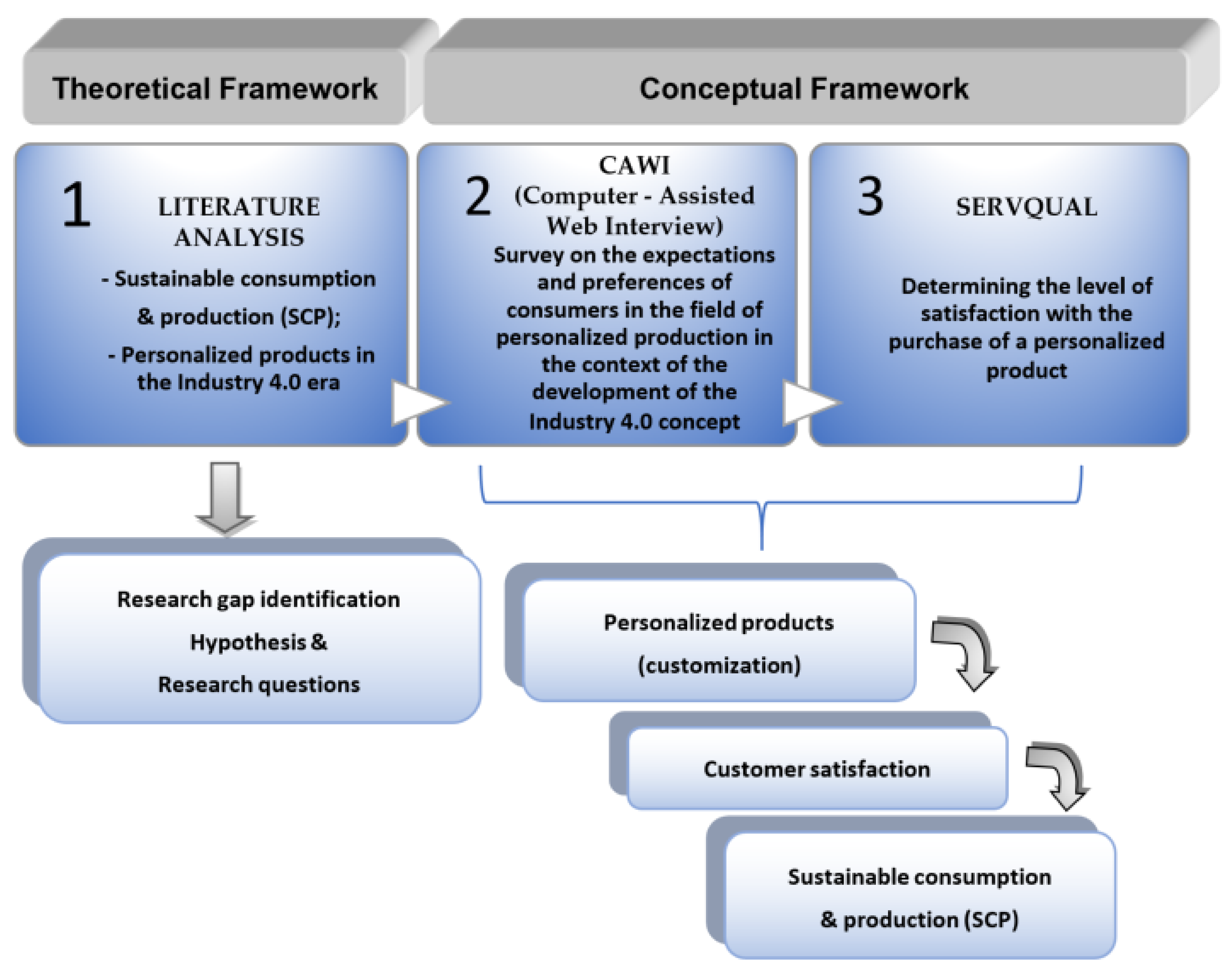

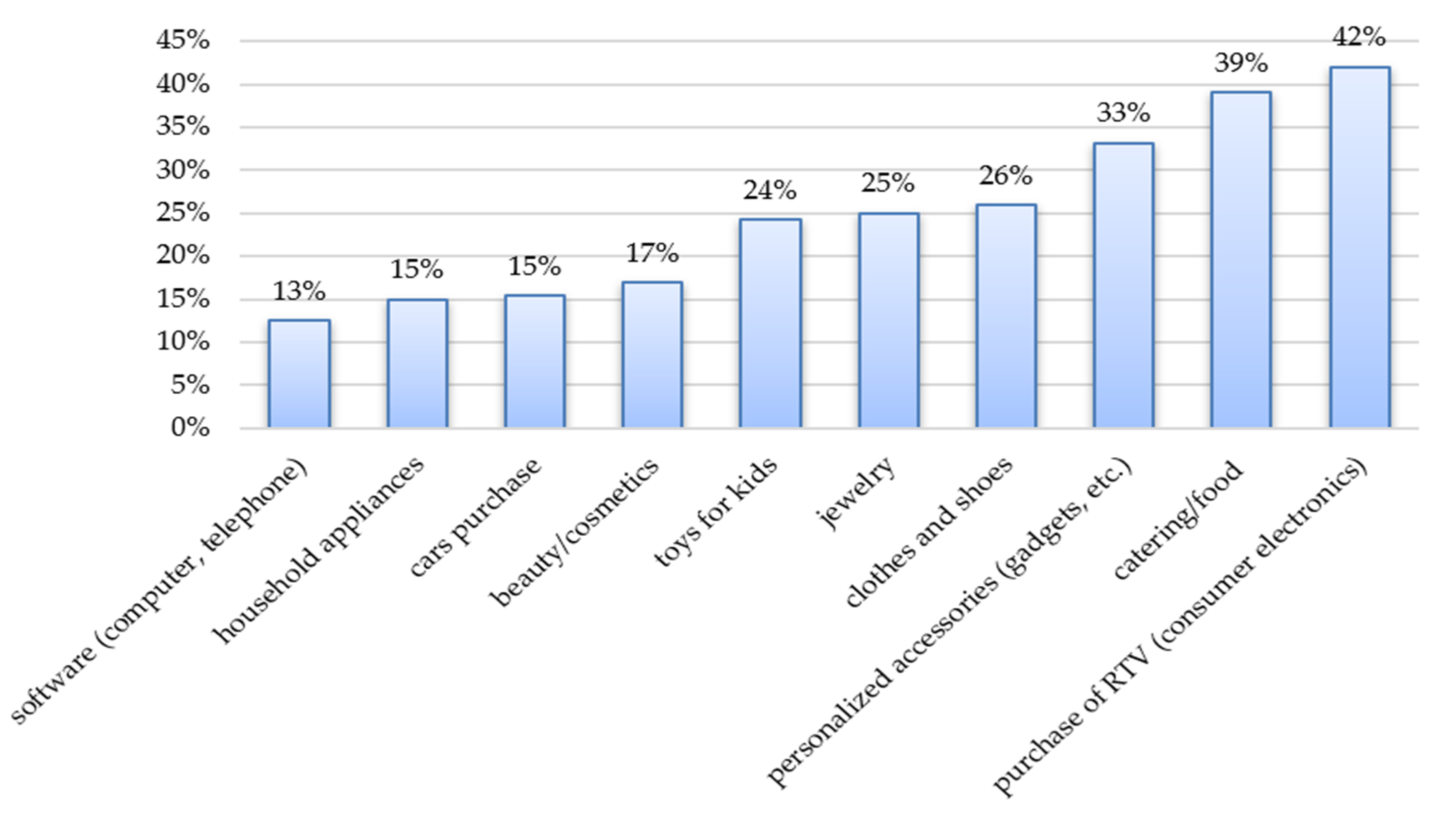

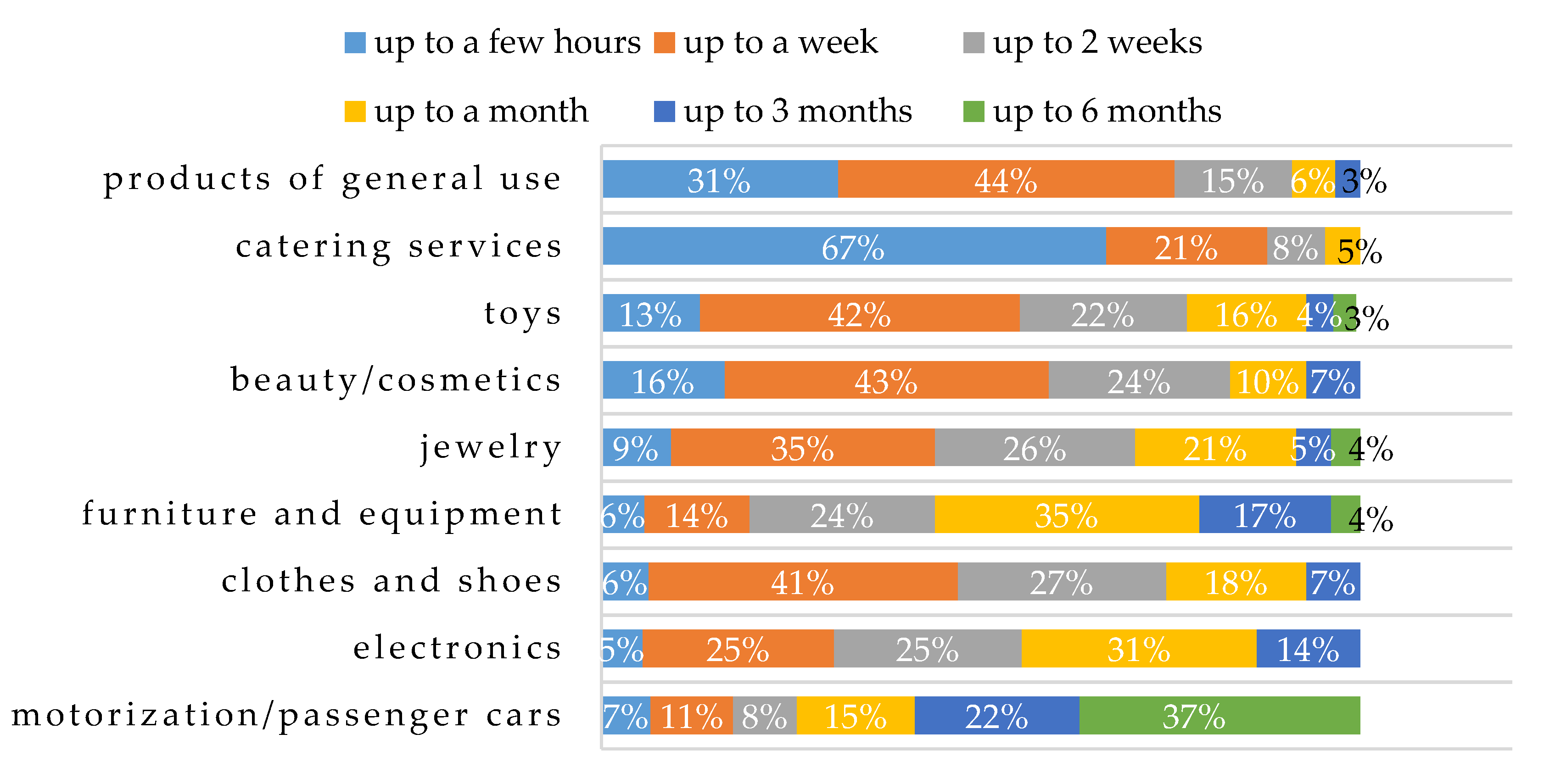


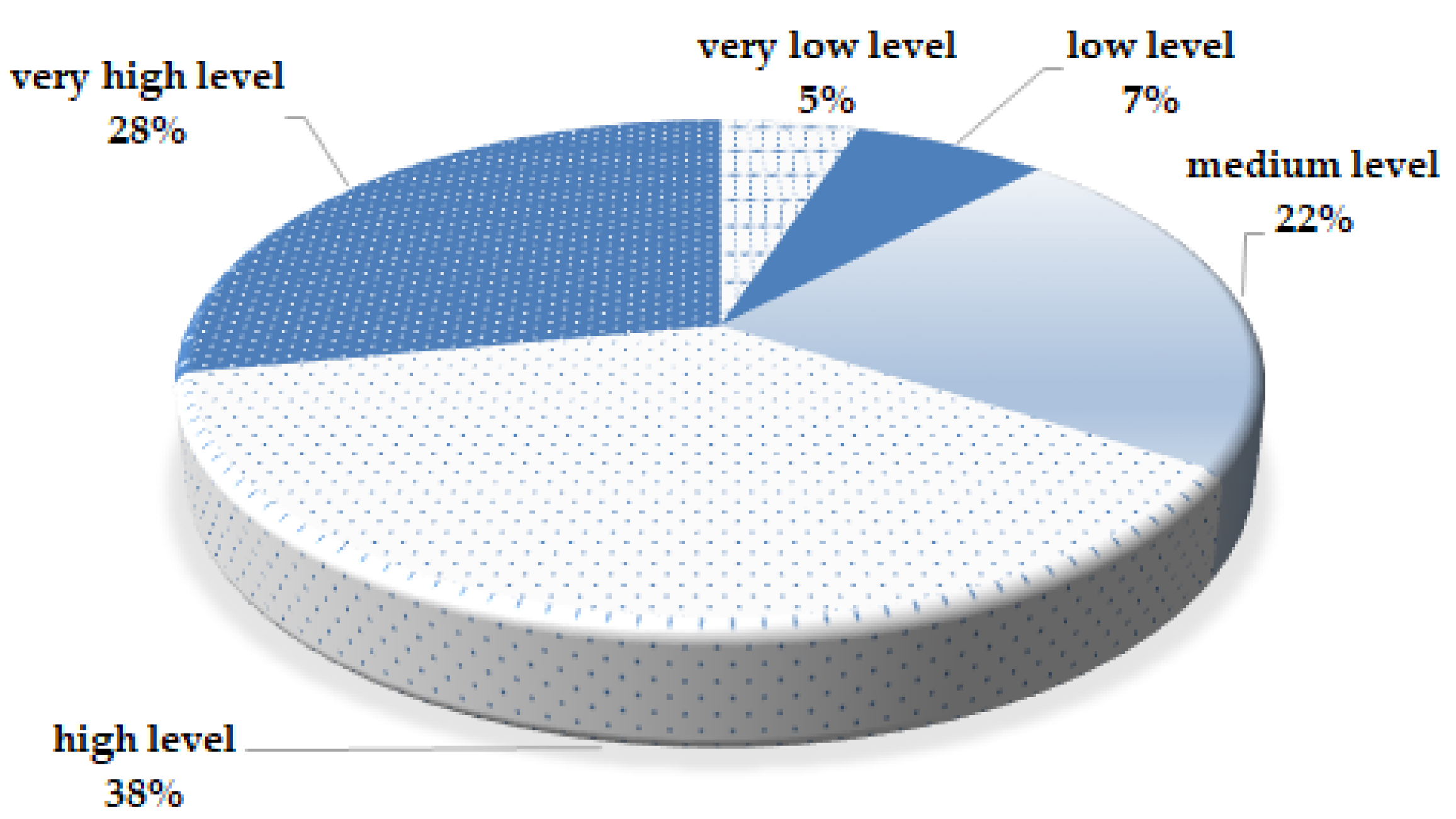


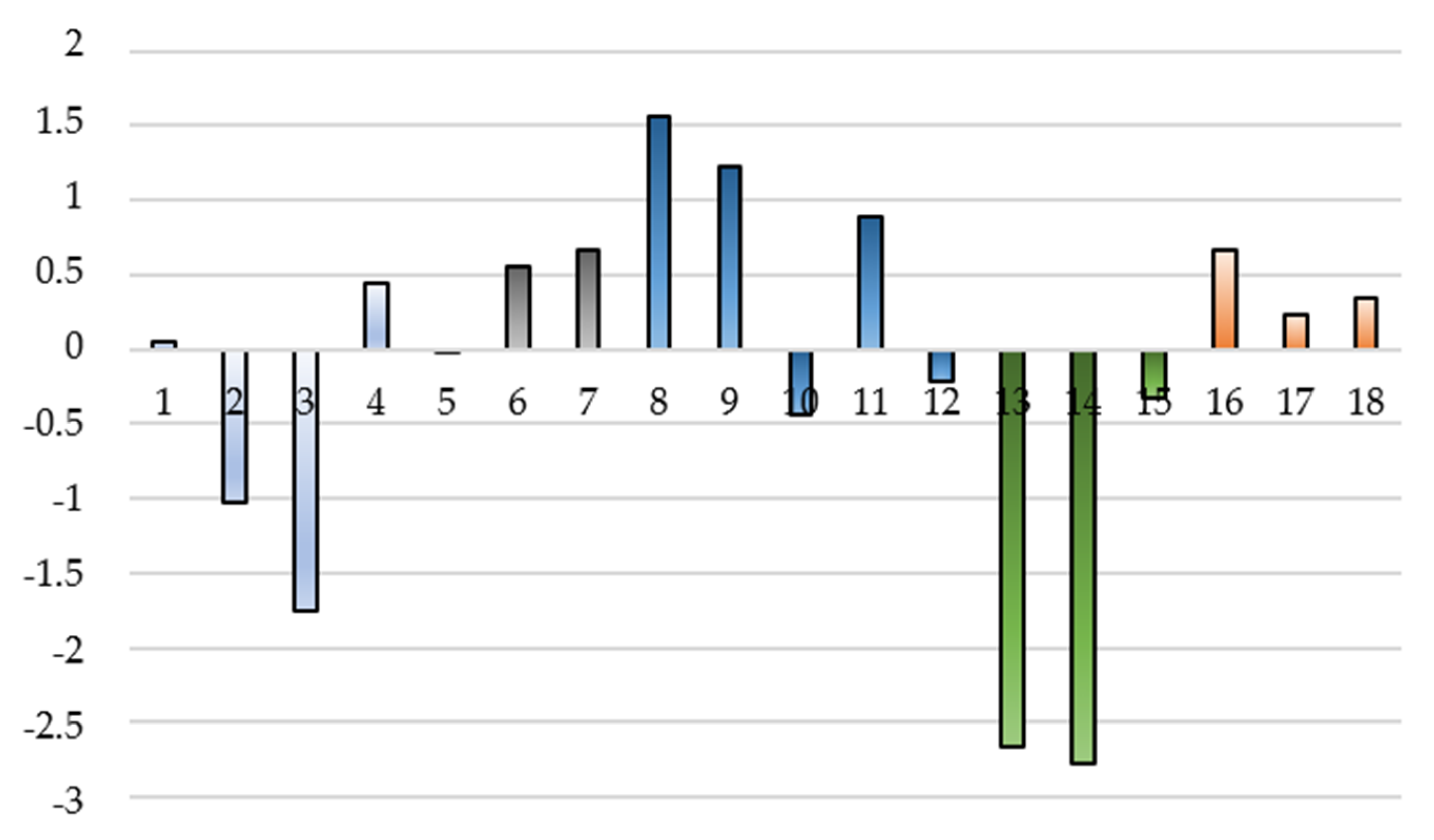
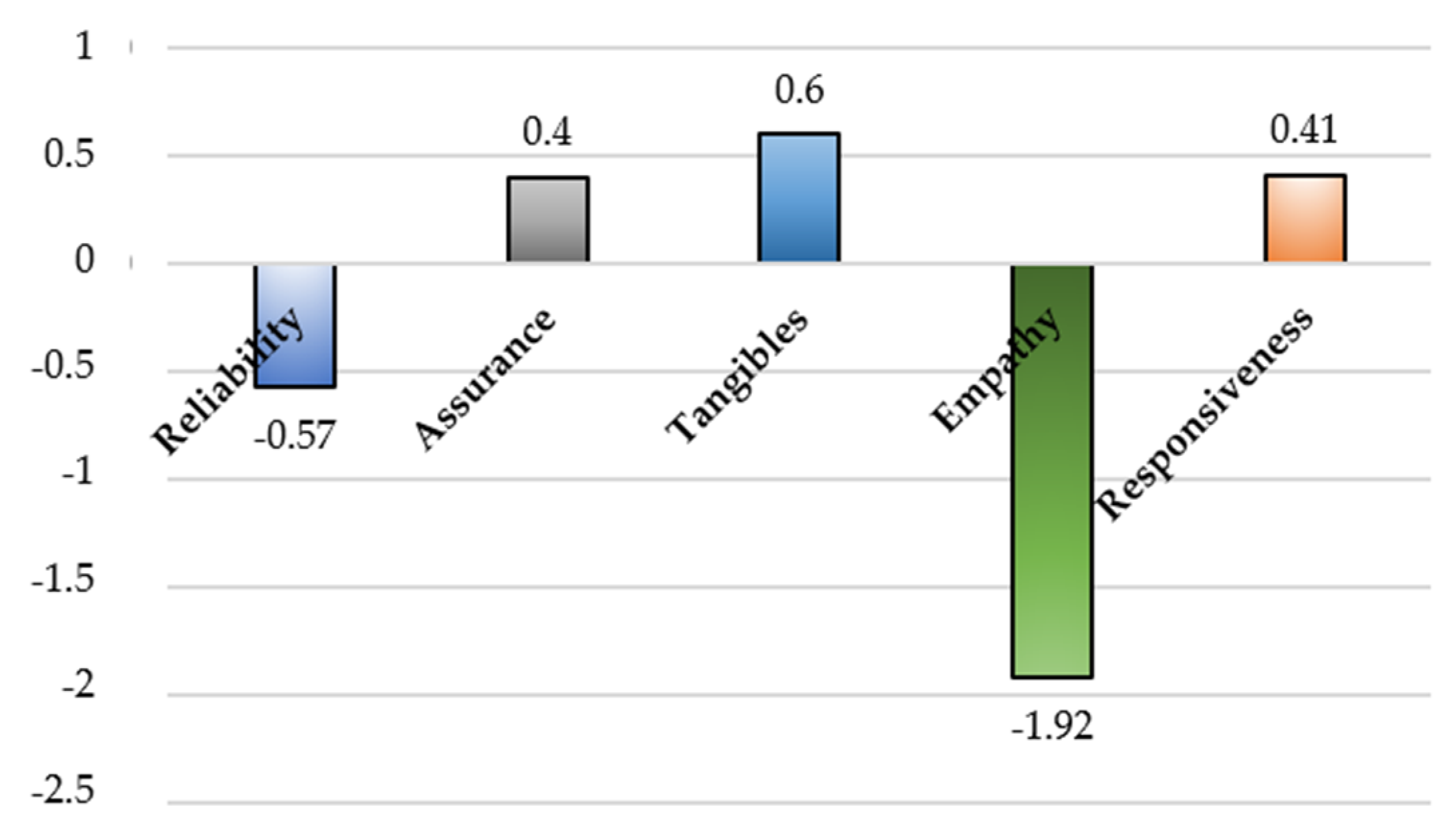
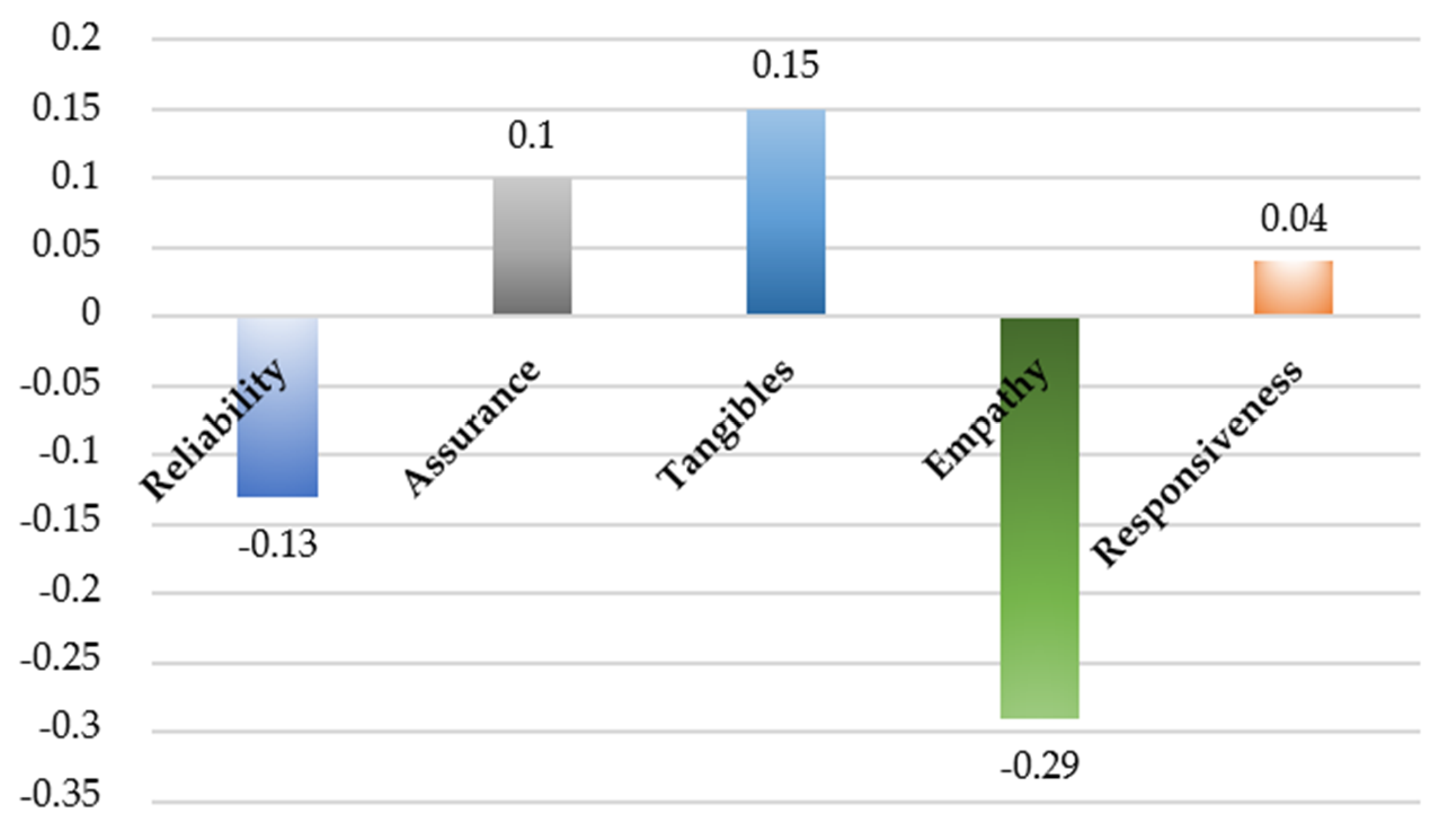
| Sex | Place of Residence | Material Situation | ||||||||
|---|---|---|---|---|---|---|---|---|---|---|
| Age\ | W | M | Village | Small Town | Medium City | Big City | Very Good | Good | Not Bad | Bad |
| Below 18 | 45 | 34 | 10 | 9 | 42 | 18 | 20 | 38 | 18 | 3 |
| 19–25 | 154 | 118 | 62 | 63 | 72 | 75 | 23 | 190 | 55 | 4 |
| 26–35 | 45 | 52 | 20 | 24 | 32 | 21 | 15 | 62 | 17 | 3 |
| 36–45 | 62 | 45 | 28 | 24 | 30 | 25 | 33 | 60 | 12 | 2 |
| 46–55 | 26 | 28 | 15 | 12 | 14 | 13 | 6 | 35 | 11 | 2 |
| 56–67 | 33 | 28 | 15 | 12 | 25 | 9 | 15 | 25 | 21 | 0 |
| Over 67 | 22 | 18 | 9 | 13 | 8 | 10 | 9 | 17 | 12 | 2 |
| /sum | 387 | 323 | 159 | 157 | 223 | 171 | 121 | 427 | 146 | 16 |
| Features | “P” are Individual Expectations towards the Purchase of a Personalized Product | “E” is the Individual’s Expectations of a Given Service Delivery | Servqual Results “SS” is the Level of Satisfaction SS = E − P |
|---|---|---|---|
| Reliability: the ability to perform the promised service dependably and accurately, reliability of a personalized product | |||
| Average Servqual for Reliability: −0.57 | |||
| 1. Reliable presentation of the offer | 6 | 6.05 | 0.05 |
| 2. Access to all information relevant to the customer | 7 | 5.98 | −1.02 |
| 3. Usefulness of the website/application with which the customer purchases a personalized product | 6 | 4.25 | −1.75 |
| 4. Reliability of a personalized product | 7 | 7.45 | 0.45 |
| Assurance: the knowledge and courtesy of employees and their ability to convey trust and confidence | |||
| Average Servqual for Assurance: 0.4 | |||
| 5. Level of customer service | 5 | 4.98 | −0.02 |
| 6. Real-time customer service | 4 | 4.56 | 0.56 |
| 7. Customer support in the process of design/creation of a personalized product | 5 | 5.66 | 0.66 |
| Tangibles: the appearance of physical facilities, equipment, personnel and communication materials, features of a personalized product | |||
| Average Servqual for Tangibles: 0.6 | |||
| 8. Page/application design | 3 | 4.56 | 1.56 |
| 9. Ease of use of the page/application | 5 | 6.23 | 1.23 |
| 10. Website/application reliability | 6 | 5.56 | −0.44 |
| 11. Quality of the personalized product | 7 | 7.89 | 0.89 |
| 12. Compliance with the design of the personalized product | 7 | 6.78 | −0.22 |
| Empathy: the provision of caring, individualized attention to customers | |||
| Average Servqual for Empathy: −1.92 | |||
| 13. Participating in the product design process | 4 | 1.34 | −2.66 |
| 14. Participation by the customer as an observer in the production process | 3 | 0.23 | −2.77 |
| 15. Choice of the method of product delivery | 6 | 5.67 | −0.33 |
| Responsiveness: the willingness to help customers and to provide prompt service | |||
| Average Servqual for Responsiveness: 0.41 | |||
| 16. Customer data security | 5 | 5.67 | 0.67 |
| 17. Security of the customized product design | 5 | 5.23 | 0.23 |
| 18. Order completion time | 6 | 6.34 | 0.34 |
| Feature Category | Evaluation | |
|---|---|---|
| Reliability | 22.85 | 0.23 |
| Assurance | 26.78 | 0.27 |
| Tangibles | 25.00 | 0.25 |
| Empathy | 15.24 | 0.15 |
| Responsiveness | 10.13 | 0.1 |
| Total score | ∑ = 100 | ∑ = 1 |
| Feature Category | Indicator Weight ∑ = 1 | Servqual Average for Each Feature Category | Weighted Average |
|---|---|---|---|
| Reliability | 0.23 | −0.57 | |
| Assurance | 0.27 | 0.4 | |
| Tangibles | 0.25 | 0.6 | |
| Empathy | 0.15 | −1.92 | |
| Responsiveness | 0.1 | 0.41 | |
| Weighted average sum of five areas | |||
| Total weighted average Servqual Sum of weighted averages for the areas under study/5 | |||
| Characteristics | Level of Overall Consumption in the Long Run | Level of Sustainable Consumption and Production | |
|---|---|---|---|
| Reliability | |||
| 1. | Reliable presentation of the offer | + | + |
| 2. | Access to all information relevant to the customer | + | + |
| 3. | The usability of the site/application with which the customer purchases a personalized product | − | + |
| 4. | Reliability of a personalized product | − | + |
| Assurance | |||
| 5. | Customer service level | + | +/− |
| 6. | Real-time customer service | −/+ | + |
| 7. | Customer support in the process of design/creation of a personalized product | − | + |
| Tangibles | |||
| 8. | Page/application design | −/+ | +/− |
| 9. | Ease of page/application operation | −/+ | + |
| 10. | Website/application reliability | −/+ | + |
| 11. | Quality of a personalized product | − | + |
| 12. | Compatibility with a personalized product design | − | + |
| Empathy | |||
| 13. | Participation in the product design process | − | + |
| 14. | Participation by the customer as an observer in the production process | − | + |
| 15. | Choice of product delivery method | +/− | + |
| Responsiveness | |||
| 16. | Customer data security | +/− | +/− |
| 17. | Security of the customized product design | − | + |
| 18. | Shorter lead times for customized products | − | + |
Publisher’s Note: MDPI stays neutral with regard to jurisdictional claims in published maps and institutional affiliations. |
© 2020 by the authors. Licensee MDPI, Basel, Switzerland. This article is an open access article distributed under the terms and conditions of the Creative Commons Attribution (CC BY) license (http://creativecommons.org/licenses/by/4.0/).
Share and Cite
Saniuk, S.; Grabowska, S.; Gajdzik, B. Personalization of Products in the Industry 4.0 Concept and Its Impact on Achieving a Higher Level of Sustainable Consumption. Energies 2020, 13, 5895. https://doi.org/10.3390/en13225895
Saniuk S, Grabowska S, Gajdzik B. Personalization of Products in the Industry 4.0 Concept and Its Impact on Achieving a Higher Level of Sustainable Consumption. Energies. 2020; 13(22):5895. https://doi.org/10.3390/en13225895
Chicago/Turabian StyleSaniuk, Sebastian, Sandra Grabowska, and Bożena Gajdzik. 2020. "Personalization of Products in the Industry 4.0 Concept and Its Impact on Achieving a Higher Level of Sustainable Consumption" Energies 13, no. 22: 5895. https://doi.org/10.3390/en13225895
APA StyleSaniuk, S., Grabowska, S., & Gajdzik, B. (2020). Personalization of Products in the Industry 4.0 Concept and Its Impact on Achieving a Higher Level of Sustainable Consumption. Energies, 13(22), 5895. https://doi.org/10.3390/en13225895







